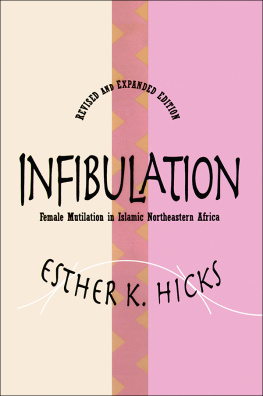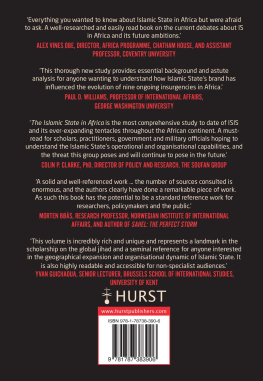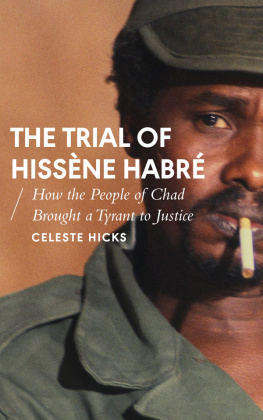Original edition published by Transaction Publishers in 1993
Published 2017 by Routledge
2 Park Square, Milton Park, Abingdon, Oxon 0X14 4RN
711 Third Avenue, New York, NY 10017
Routledge is an imprint of the Taylor and Francis Group, an informa business
Second edition, revised and expanded copyright 1996 by Taylor & Francis.
All rights reserved. No part of this book may be reprinted or reproduced or utilised in any form or by any electronic, mechanical, or other means, now known or hereafter invented, including photocopying and recording, or in any information storage or retrieval system, without permission in writing from the publishers.
Notice:
Product or corporate names may be trademarks or registered trademarks, and are used only for identification and explanation without intent to infringe.
Library of Congress Catalog Number: 95-39572
Library of Congress Cataloging-in-Publication Data
Hicks, Esther K.
Infibulation : female mutilation in Islamic northeastern Africa / Esther K. Hicks.Rev. ed.
p. cm.
Includes bibliographical references (p.) and index.
ISBN 1-56000-841-5 (pbk.: alk. paper)
1. InfibulationAfrica, Northeast. 2. Africa, NortheastSocial life and
customs. 3. Muslim womenAfrica, Northeast. I. Title.
GN650.H53 1996
392dc20
95-39572
CIP
ISBN 13: 978-1-56000-841-5 (pbk)
Figures
Figure 1.1: Vulva (External Genitalia)
Maps
Map 1: General Regions Where Infibulation Occurs
Map 2: General Distribution of Infibulation and Major Historical Trade Routes
Map 3: Distribution of Infibulation According to Subsistence
Map 4: General Distribution of Agriculturalists, Agro-Pastoralists, and Pastoralists
Map 5: General Distribution of Pastoralists
Map 6: Provinces of the Sudan and Population Density
Map 7: Sudan: Distribution of Agriculturalists, Agro-Pastoralists, and Pastoralists
Map 8: Distribution and Colonial Divisions (1935)the Horn Area
Map 9: The Horn: Agricultural, Agro-Pastoral, and Pastoral Distribution
Map 10: Estimated Distribution of Listed Populations: Sudan/Eastern Chad
Map 11: Estimated Distribution of Populations Practicing Infibulation: Sudan/Eastern Chad
Map 12: Estimated Distribution of Populations Practicing Infibulation in the Horn
Plots
Plot 1: HOMALS Discrimination Measures (all vars.)
Plot 2: HOMALS Infibulating/Noninfibulating Population Plot
Plot 3: HOMALS Variable Category Plot
Plot 4: HOMALS Discrimination Measures
Plot 5: HOMALS Infibulation Data Plot
Plot 6: HOMALS Population Data
Tables
Table 1.1: Estimated Total Somali Population, and Percentage and Distribution of Nomads
Table 2.1: Farmers and Farm Laborers and Animal Owners and Herders
Table 2.2: Population Distribution According to Settlement Patterns
Table 3.1: Census Data for Sudan for 1964
Table 3.2: Total Population and Percentage of Males by Age Group for Ethiopia for 1970, 1975, and 1980
Table 3.3: Total Population and Number of Males/Females per Region (in thousands) in Somalia for 1975
Table 3.4: Crude Birthrate and Infant Mortality Rates for the Sudan (from 1956 census data)
Table 4.1 A-F: A Listing of the Variables Considered
Table 4.2: Frequency Distribution of the Variables
Table 4.3 A-E and Related Graph: Infibulation Data and Frequency Distribution of the Variables
Table 4.4 and Related Graphs A-C: Discrimination Measures
Table 4.5 and Related Graph: Variables with High Discrimination Measures on the Several Dimensions
Table 4.6: Labels of the Populations and Population Categories Used in the HOMALS Plots
Table 4.7: Labels of the Categories Used in the HOMALS Plots
Table 4.8: The Position (scores) of the Objects on HOMALS Dimension 1
Table 4.9: The Position (scores) of the Categories on HOMALS Dimension 1
Table 6.1: Life Expectancy at Birth (years)
Table 6.2: Percentage of Circumcised Ever-Married Women Favoring Continuation of Circumcision, by Region in the Sudan for 1989-1990
Table 6.3: Number and Percentage of Circumcised Ever-Married Women Favoring Continuation of the Three Forms in the Sudan, 1989-1990
Table 6.4: Circumcised Ever-Married Womens Preference for Infibulating Their Daughters
Appendix
Table A.1: Population According to Religious Affiliation
Table A.2: Distribution of Religions in Eritrea and Ethiopia (1952)
Table A.3: Distribution of Religions in Somalia (1952)
Table A.4: Labels Used in Maps 10 and 11
Infibulation, the most extreme form of female circumcision, is primarily practiced by those populations inhabiting Islamic northeastern Africa. For these populations, circumcising young girls and boys is an important part of their normative socialization process. For outside observers such operations are more often perceived as a mutilation of young children. In recent years this perception has received considerable publicity as increasing attention has been drawn to the various forms of female circumcision. Moreover, such practices have all too often been exploited in the media as portraying a specific, albeit symbolic, example of mans inhumanity to woman. This is especially so with respect to infibulation: the justification of its perpetuation is perceived as having its basis in the manipulation of holy writ.
But is this, in fact, the case? Or is infibulation but one of a myriad of cultural traits developed, over time, by individual social systems to define and circumscribe the social role of those members most pivotal to its structural survival? In this case, women. And why do we refrain from politically platforming the rights of young boys? Is the traditional symbolic basis of circumcising young children of either sex really so different? Or is the primary difference between the circumcision operation for boys and girls one of degree and not kind; that is, infibulating young female children can have serious immediate, and long-term, medical consequences, whereas the circumcision of young boys leaves primarily invisible scars? Perhaps of equal relevance is the question of what the (small) war waged by feminists and the various international interest groups against all forms of female circumcision tells us about our own cultural biases and insecurities. Would we not be better served by first determining the importance and embeddedness of this practice in the social systems within which it occurs?
This is especially important in the light of the growing numbers of refugees seeking resettlement in western societies. Here the issue becomes one of how to ensure the socioeconomic adjustment of (non-European) refugees to their new social environment: a task for which western technologically developed societies are ill equipped.
The aim of this book is to contribute to an understanding of the historical sociocultural embeddedness of the practice of infibulation. The paucity of reliable and extensive field studies necessitated a historical approach. On the one hand, this aided the determination of (1) the original geographic and cultural (population) distribution of infibulation; (2) the potential historical function(s) of this practice; (3) the reason for the current distribution of this practice across the entire pastoral-rural-urban continuum. On the other hand, it resulted in a considerably more conservative delineation of the geographic distribution of this practice than that indicated by other studies (academic or otherwise). Similarly, and in the interests of historical continuity, the traditional (geographic) provincial designations were retained throughout this study (especially for Sudan).













